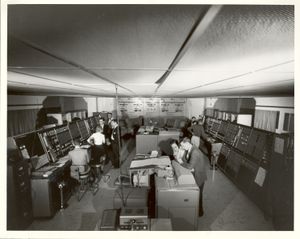SAGE (Semi-Automatic Ground Environment): Difference between revisions
No edit summary |
No edit summary |
||
| (20 intermediate revisions by 4 users not shown) | |||
| Line 1: | Line 1: | ||
[[Image:Sage.jpg|thumb|right|SAGE demonstrated pioneering solutions to the problem of the user interface. Courtesy: The MITRE Corporation.]] | |||
[[Image:Sage control consoles 4426.jpg|thumb|Separate Sage control consoles (including standard IBM punched card equipment) and magnetic tape unites were provided for each of the duplexed computers]] | |||
Jay Forrester and George Valley from MIT's Lincoln Lab conveived of a continental air-defense system that integrated radar, communications and computers designed to track and intercept hundreds of incoming aircraft. This became the | [[Jay W. Forrester|Jay Forrester]] and George Valley from [https://ethw.org/MIT_Lincoln_Laboratory MIT's Lincoln Lab] conveived of a continental air-defense system that integrated radar, communications and computers designed to track and intercept hundreds of incoming aircraft. This became the (Semi-Automatic Ground Environment) system, the largest computer project of its time. | ||
SAGE is a landmark in the history of both radar and computing. The SAGE air-defense system was built by the United States in the 1950s. It used radar on land, at sea, and in the air and was a major advance in telecommunications. A network of 23 control centers was built, each center receiving information from some 100 sources, principally radar stations. The surveillance and communications demands were met by real-time computerized processing of information. The computer for SAGE, the AN/FSQ7 built by IBM, was the first full-production machine with a [[Magnetic-Core Memory|magnetic core memory]] and the first to have a standby computer in case of machine failure. Each AN/FSQ7 weighed 250 tons and contained 49,000 electron tubes. | |||
Most of the human-machine interaction took place at large radar screens with light pens, rather than with punched cards or teletype terminals. The first test of SAGE—directing an interceptor plane to a target—occurred on 20 April 1951. The system performed well. However, it was not until 1 July 1958 that the first SAGE center went into regular operation.The system was fully operational by 1963. | Most of the human-machine interaction took place at large radar screens with light pens, rather than with [[Early Punched Card Equipment, 1880 - 1951|punched cards]] or teletype terminals. The first test of SAGE—directing an interceptor plane to a target—occurred on 20 April 1951. The system performed well. However, it was not until 1 July 1958 that the first SAGE center went into regular operation.The system was fully operational by 1963. In 1956,[https://ethw.org/Robert_R._Everett Robert Everett] became head of Lincoln Lab's Division VI, responsible for SAGE system design and testing. | ||
[[Category: | |||
{{Timeline | |||
|Date=1/1/1963 | |||
|Priority=Electrical | |||
|Description=The SAGE air-defense system, a landmark in the history of both radar and computing, was fully operational by 1963. Built by the United States in the 1950s, it used radar on land, sea, and air radar. It met surveillance and communications demands through real-time computerized information processing. | |||
}} | |||
[[Category:Signals]] | |||
[[Category:Signal_processing]] | |||
[[Category:Radar_signal_processing]] | |||
[[Category:Computing_and_electronics]] | |||
[[Category:Computer_applications]] | |||
[[Category:Military_computing]] | |||
[[Category:Engineering_and_society]] | |||
[[Category:Military_applications]] | |||
[[Category:Cold_War]] | |||
Latest revision as of 20:11, 11 September 2018
Jay Forrester and George Valley from MIT's Lincoln Lab conveived of a continental air-defense system that integrated radar, communications and computers designed to track and intercept hundreds of incoming aircraft. This became the (Semi-Automatic Ground Environment) system, the largest computer project of its time.
SAGE is a landmark in the history of both radar and computing. The SAGE air-defense system was built by the United States in the 1950s. It used radar on land, at sea, and in the air and was a major advance in telecommunications. A network of 23 control centers was built, each center receiving information from some 100 sources, principally radar stations. The surveillance and communications demands were met by real-time computerized processing of information. The computer for SAGE, the AN/FSQ7 built by IBM, was the first full-production machine with a magnetic core memory and the first to have a standby computer in case of machine failure. Each AN/FSQ7 weighed 250 tons and contained 49,000 electron tubes.
Most of the human-machine interaction took place at large radar screens with light pens, rather than with punched cards or teletype terminals. The first test of SAGE—directing an interceptor plane to a target—occurred on 20 April 1951. The system performed well. However, it was not until 1 July 1958 that the first SAGE center went into regular operation.The system was fully operational by 1963. In 1956,Robert Everett became head of Lincoln Lab's Division VI, responsible for SAGE system design and testing.

